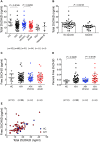Association of serum 25-hydroxyvitamin D levels with severe necroinflammatory activity and inflammatory cytokine production in type I autoimmune hepatitis
- PMID: 33151930
- PMCID: PMC7643962
- DOI: 10.1371/journal.pone.0239481
Association of serum 25-hydroxyvitamin D levels with severe necroinflammatory activity and inflammatory cytokine production in type I autoimmune hepatitis
Abstract
25-Hydroxyvitamin D [25(OH)D] has been reported to be associated with several chronic liver diseases. The relationship between 25(OH)D and autoimmune hepatitis (AIH) pathogenesis is incompletely understood. We investigated the association of serum total and free 25(OH)D levels with necroinflammatory activity and cytokine levels in 66 patients with AIH diagnosed in our hospital. The median age at AIH diagnosis was 57 years, and the male:female ratio was 7:59. The median serum total 25(OH)D level in therapy-naïve patients with AIH was 14.2 ng/mL (interquartile range [IQR], 11.4-17.9 ng/mL). Of the 66 patients with AIH, 36 had serum total 25(OH)D levels of < 15 ng/mL and were considered to have vitamin D deficiency, and 30 had serum total 25(OH)D levels of ≥ 15 ng/mL. Patients with acute-onset AIH had significantly lower serum total 25(OH)D levels than those with chronic-onset AIH. In particular, serum total 25(OH)D levels were significantly lower in patients with severe forms of AIH. Furthermore, the serum total 25(OH)D level was positively correlated with the serum albumin level and prothrombin time and negatively correlated with the serum total bilirubin level and necroinflammatory activity in AIH. Multivariate logistic regression analysis showed that the serum total 25(OH)D level was an independent factor for severe necroinflammatory activity. Interestingly, AIH patients with serum total 25(OH)D levels of < 15 ng/mL had higher levels of inflammatory cytokines such as interferon-γ and interleukin-33. Free 25(OH)D levels were correlated with total 25(OH)D levels, and the percentage of free 25(OH)D was significantly associated with necroinflammatory activity. In conclusion, 25(OH)D deficiency may play an important role in predicting AIH severity via inflammatory cytokine production.
Conflict of interest statement
Kazumichi Abe and Hiromasa Ohira has received research funds from AbbVie Inc. All other authors declare no conflict of interest. This does not alter our adherence to PLOS ONE policies on sharing data and materials.
Figures


References
Publication types
MeSH terms
Substances
LinkOut - more resources
Full Text Sources
Medical

